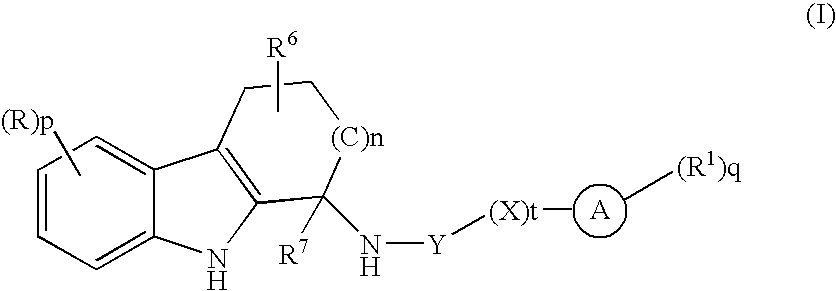Tetrahydrocarbazole derivatives and their pharmaceutical use
a technology of tetrahydrocarbazole and derivatives, which is applied in the direction of heterocyclic compound active ingredients, biocide, drug compositions, etc., can solve the problems of no effective antiviral treatment for hpv infection, and high risk of hpv infection, and achieves the effect of reducing the risk of invasive cancer
- Summary
- Abstract
- Description
- Claims
- Application Information
AI Technical Summary
Benefits of technology
Problems solved by technology
Method used
Image
Examples
example 1
6-Chloro-2,3,4,9-tetrahydro-1H-carbazol-1-one
[0231]
a) Cyclohexane-1,2-dione (4-chlorophenyl)hydrazone
[0232] To a cold (0° C.) solution of 4-chloroaniline (5.6 g, 44 mmol) in concentrated hydrochloric acid (5 mL) was added sodium nitrite (3.0 g, 44 mmol) dissolved in water (10 mL) portionwise over 20 minutes. The mixture was stirred at 0° C. for 30 minutes. In a separate flask, a cool solution of 2-(hydroxymethylene)cyclohexanone (Organic Syntheses, Collective Vol 4, 1963, pg. 536) (5.0 g, 40 mmol) in methanol (30 mL) was treated with a solution of sodium acetate (8.3 g, 101 mmol) in water (25 mL). The mixture was stirred at 0° C. for 20 minutes and the diazonium salt slurry was added. The combined mixture was stirred for 10-15 minutes, collected by filtration, triturated with ethanol, and collected by filtration to give cyclohexane-1,2-dione (4-chlorophenyl)hydrazone (4.6 g, 49% yield) as a yellow solid. 1H-NMR (DMSO-d6): δ 9.93 (s, 1H), 7.29 (m, 4H), 2.55 (m, 2H), 2.40 (m, 2H), 1...
example 2
6-Chloro-2,3,4,9-tetrahydro-1H-carbazol-1-amine
[0234]
[0235] To a solution of 6-chloro-2,3,4,9-tetrahydro-1H-carbazol-1-one (500 mg, 2.3 mmol) and ammonium acetate (1.8 g, 23 mmol) in methanol (9 mL) was added sodium cyanoborohydride (720 mg, 11.5 mmol). After heating at 60° C. for 15 hours, the mixture was cooled and treated with concentrated hydrochloric acid until pH=1. The organics were removed under reduced pressure and the resulting precipitate was collected by filtration, dissolved in ethyl acetate and methanol, and washed with saturated aqueous sodium carbonate. The phases were separated and the organic phase was concentrated to yield 6-chloro-2,3,4,9-tetrahydro-1H-carbazol-1-amine (260 mg, 52% yield) as a light brown solid. 1H-NMR (DMSO-d6): δ 10.90 (s, 1H), 7.34 (m, 1H), 7.27 (d, 1H), 6.97 (dd, 1H), 3.90 (t, 1H), 2.54 (m, 2H), 2.04-1.89 (m, 2H), 1.66 (m, 1H), 1.50 (m, 1H); MS m / z 221 (M+1).
example 3
6-Bromo-2,3,4,9-tetrahydro-1H-carbazol-1-one
[0236]
[0237] 6-Bromo-2,3,4,9-tetrahydro-1H-carbazol-1-one was prepared from bromoaniline and 2-(hydroxymethylene)cyclohexanone in a similar manner as described in Example 1 to give a brown solid. 1H-NMR (CDCl3): δ 8.79 (s, 1H), 7.80 (s, 1H), 7.44 (d, 1H), 7.30, (d, 1H), 2.97 (t, 2H), 2.66 (t, 2H), 2.27 (quint, 2H); MS m / z 265 (M+1).
PUM
 Login to View More
Login to View More Abstract
Description
Claims
Application Information
 Login to View More
Login to View More - R&D Engineer
- R&D Manager
- IP Professional
- Industry Leading Data Capabilities
- Powerful AI technology
- Patent DNA Extraction
Browse by: Latest US Patents, China's latest patents, Technical Efficacy Thesaurus, Application Domain, Technology Topic, Popular Technical Reports.
© 2024 PatSnap. All rights reserved.Legal|Privacy policy|Modern Slavery Act Transparency Statement|Sitemap|About US| Contact US: help@patsnap.com










